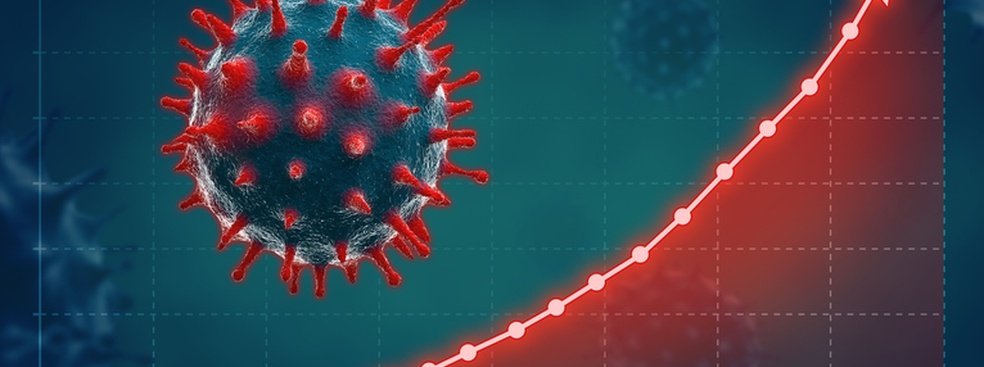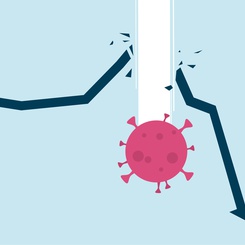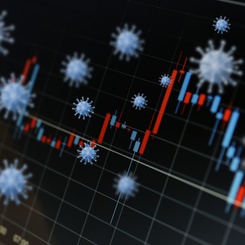The spread of Covid-19 has put the entire world under an unprecedented pressure. In this context, any tool that can give us reliable predictions on the development of the pandemic is invaluable. Data on the spread of Covid-19 from different countries is analyzed to try to predict what we can expect from the epidemic.
In the very beginning of the Covid-19 epidemic, scientists began to talk about the exponential growth of the number of cases. This growth indicates that the number of infected people always doubles after the same time frame, very quickly leading to alarming numbers. In some countries, including France, people are enduring quarantines with strict restrictions. The goal of these restrictions is to slow down the rate of exponential growth. Without such restrictions, will growth continue to be exponential? Evidently, no, as if a large part of the population already has or has had the virus, growth will slow, first becoming linear and then stopping completely.
The rate of exponential growth depends on the basic reproduction number, R0, which refers to the number of people infected by a person with the infection. This number is estimated to be around 2.5 for Covid-19. If the reproduction number is larger than 1, the number of cases grows exponentially. So to stop it or slow it down, we need to reduce this number, getting it down to a number equal to or smaller than 1. In reality, if we assume that those who have already been infected are now immune, the reproduction number depends on the proportion r of people who have already been infected, meaning it is equal to R0(1−r). The more people who are immunized, the lower the reproduction rate. The epidemic will stop propagating once R0(1−r) is less than 1. If we assume that the current basic reproduction number is 2.5, this requires 60% of the population to be immunized, which seems far too high a figure given current estimates of the case fatality rate of Covid-19. It is clear from this model that lifting the confinement will be tricky. If there is not sufficient herd immunity, i.e. the proportion of r is not high enough, and there are still a non-negligible number of patients, the exponential growth is likely to resume.
Generally speaking, models used to predict the evolution of epidemics have been known for a while now. They are based on differential equations that describe the evolution of the number of people who are healthy, susceptible, infectious, and recovered. Once the basic parameters have been estimated, these models can make predictions about the size and possible length of the epidemic. It should be noted that these models are a simplification of reality as they do not take into account many factors that can influence the propagation of a virus, for example how people interact with one another. The predictions that these models provide are only useful if we have good estimates of the basic parameters. Is this the case for Covid-19? Unfortunately, the estimates of certain key parameters are still rather fuzzy.
Take, for instance, the example of the case fatality rate and the proportion of people who are contaminated (the prevalence). These two parameters are essential to predict the evolution of an epidemic and the likely number of victims. Obtaining reliable estimates of these two parameters is complicated by the fact that we have incomplete data for the number of deceased and the number of cases. In reality, we don’t know how many people have been infected by Covid-19 and how many people have passed away from it. The publicly released numbers represent the number of people who have passed away after receiving a positive diagnosis of Covid-19 or after a post-mortem diagnosis. This means that the true number of Covid-19 deaths is unclear, since perhaps the individual did not undergo a test or showed a false negative.
What’s more, understanding the dynamics of the number of infected people is essential to determining the basic reproduction number and the case fatality rate. One crucial data point that we are lacking is the number of asymptomatic cases or cases with mild symptoms, which are not included in the official statistics. The low testing rate in France makes the true number of cases quite unclear. The problem is that even for making projections of a few weeks out, a difference of a few points can produce vastly different results. To create effective strategies to lift the confinement, we need reliable data. This means that obtaining data that reflects the reality of the pandemic is of the utmost importance.
One solution would be to execute random daily tests of the population to get a more realistic idea of the number of cases and the evolution of Covid-19’s spread. However, this would be challenging to put in place under the current confinement conditions and with the limited tests available. We must come up with innovative solutions to collect epidemiological data that can address the challenges of the Covid-19 pandemic that will undoubtedly spawn new developments in the methodology of epidemiological studies.









